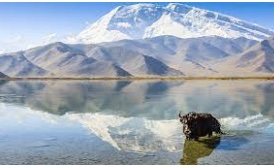- The Qinghai-Tibet Plateau Act is China’s first legislative vision for the environmental protection of the Tibetan plateau and its surroundings, covering an area larger than western Europe.
- Hailed as a legislative landmark by state-sponsored media, its effects could ripple far beyond China’s borders, with likely effects on international rivers such as the Brahmaputra, Indus, Mekong, Irrawaddy and Salween, which flow from the Tibetan plateau.
- In a new commentary, a conservation biologist concerned about the QTP ecosystem explains how its 63 articles cover a nearly panoramic selection of topics, making the act a good starting point for understanding the major environmental issues of the region.
- This article is a commentary. The views expressed are those of the author, not necessarily of Mongabay.
In April, the National People’s Congress, China’s legislative branch, passed the “Qinghai-Tibet Plateau (QTP) Ecosystem Protection Act” (hereafter referred to as the QTP Act). The QTP Act is China’s first legislative vision for the environmental protection of the Tibetan plateau and its surroundings, covering an area of 2.6 million km2, larger than the entirety of western Europe. The act is hailed as a legislative “landmark” by state-sponsored Chinese media and follows a series of laws that provide a legal backbone for resolving China’s regional environmental issues along the Yangtze River (2020), Yellow River (2022), and the Northeastern Plains (2022).
But unlike previous regional legislation, effects of the QTP Act could ripple far beyond China’s administrative borders. For example, major international rivers such as the Brahmaputra, Indus, Mekong, Irrawaddy and Salween flow from the heights of the Tibetan plateau, thus its nickname “water tower” for 1.5 billion people in Asia. The Tibet Autonomous Region (TAR, a province-level administrative region of China established after the annexation of Tibet) shares a 2,000 km border with Nepal, Bhutan, India and Pakistan.
Together with China, these five Himalayan nations account for the world’s first, second and fifth most populous countries. Loosely regulated dam construction along the Tibetan segment of the Brahmaputra River (referred to as Yarlung Tsangpo in Tibetan), is among one of many bones of contention along the flammable Sino-India border. The 10 million people living on the QTP, as well as China’s Himalayan neighbors, have vested interest in how China decides to maintain the “water tower of Asia”— especially as its ice reserves continue to dwindle due to climate change. These administrative legalities are laid out in the QTP Act.
Read in full
China’s Qinghai-Tibet ecosystem legislation is a landmark, but for whom? (commentary)




